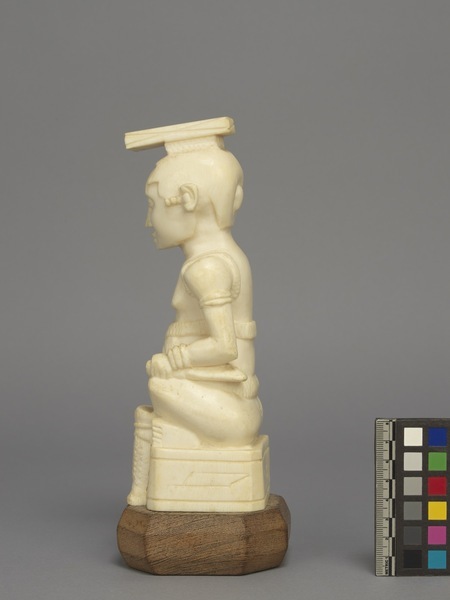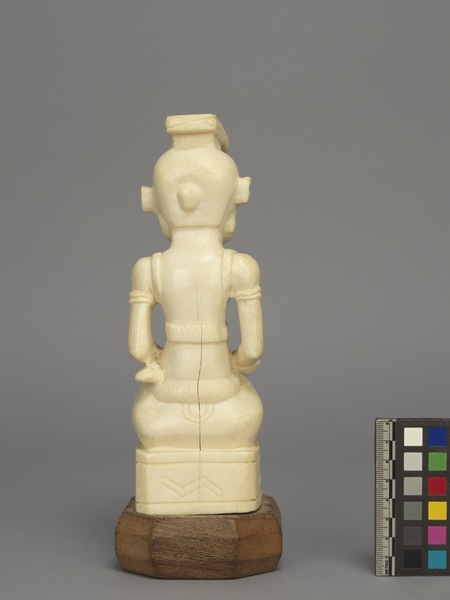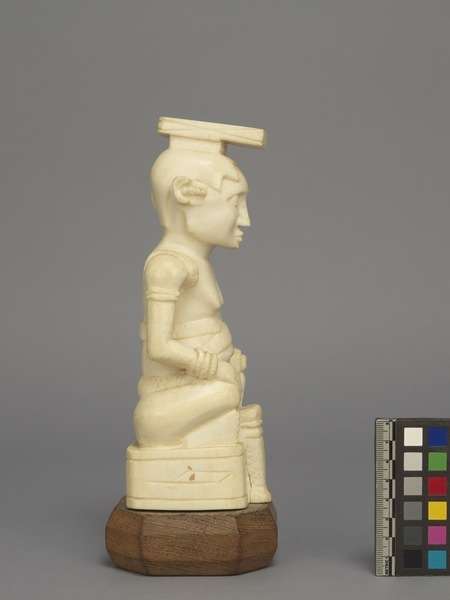Figure Item Number: 3321/5 from the MOA: University of British Columbia




Description
King figure (ndop) made of carved ivory. Figure sits cross-legged on a square platform with a drum(?) in front. His eyes are closed, right hand placed on his knee, and he holds a ceremonial knife in his left hand. He wears a distinctive projecting hoe-shaped headdress with carved decoration around the edge and on the top surface. His regalia includes cane shoulder hoops, cloth plaque covering the buttocks, a wrapped belt that crosses over his abdomen, and a plaited belt. He also wears three bracelets, two arm rings and ear ornaments. The figure is mounted on a wood octagonal base.
History Of Use
The ndop is used as a surrogate when the king is absent from the capital. When the king dies, the new king must sleep with the ndop of the deceased king to absorb his ngesh (bush spirit). Afterwards, the ndop becomes a symbol of remembrance and is occasionally displayed, but is commonly kept by the king's widow. In ndop portraits, the king is usually shown full-bellied and breasted, with a large head and cowrie shell-shaped eyes. The hair is shaped in patterns worn by royals on important occasions, and the king's short sword is held in his left hand, as it was for major ceremonies. Other common distinctive characteristics are the circular neck ring, cane shoulder hoops (or hippopotamus teeth), cloth plaque covering the buttocks, and the forward-extending royal headdress. The ibol (king's individual and identifying symbol) would be attached to the pedestal of the ndop, at the base. The earliest Kuba ndop portrait dates to the beginning of the 18th century; believed to have been introduced by King Misha mi-Shyaang a-Mbul. Today, ndop are thought to represent Kuba pride and heritage, be an epitome of African sculpture, and are used as a symbol of tribalism.
Narrative
Collected by the donor in Kinshasa in 1941.
Iconographic Meaning
The cowrie shell-shaped eyes of ndop symbolize royal wealth.
Item History
- Made in Democratic Republic of the Congo
- Collected during 1941
- Owned by Roxane Connick Carlisle before September 17, 2018
- Received from Roxane Connick Carlisle (Donor) on September 17, 2018
What
- Name
- Figure
- Identification Number
- 3321/5
- Type of Item
- figure
- Material
- elephant ivory and wood
- Overall
- height 24.4 cm, width 8.9 cm, depth 9.2 cm
Who
- Culture
- Kuba
- Previous Owner
- Roxane Connick Carlisle
- Received from
- Roxane Connick Carlisle (Donor)
Where
- Holding Institution
- MOA: University of British Columbia
- Made in
- Democratic Republic of the Congo
When
- Collection Date
- during 1941
- Ownership Date
- before September 17, 2018
- Acquisition Date
- on September 17, 2018
Other
- Item Classes
- carvings & sculpture
- Condition
- fair
- Accession Number
- 3321/0005